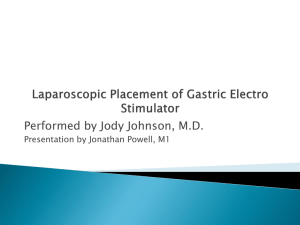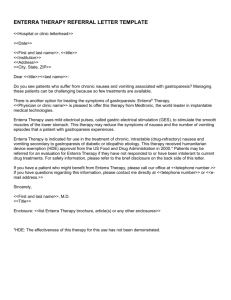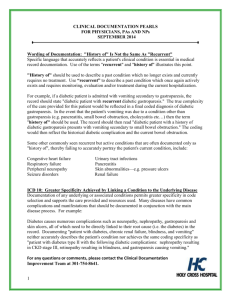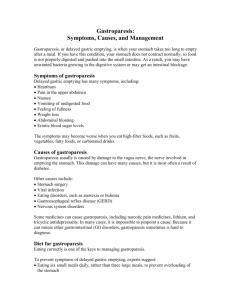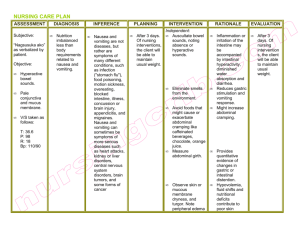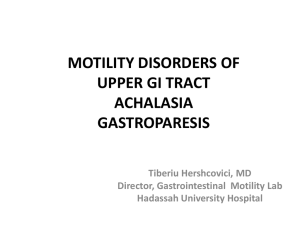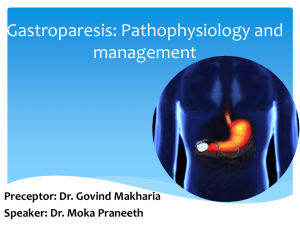History of Gastric Electrical Stimulation
advertisement
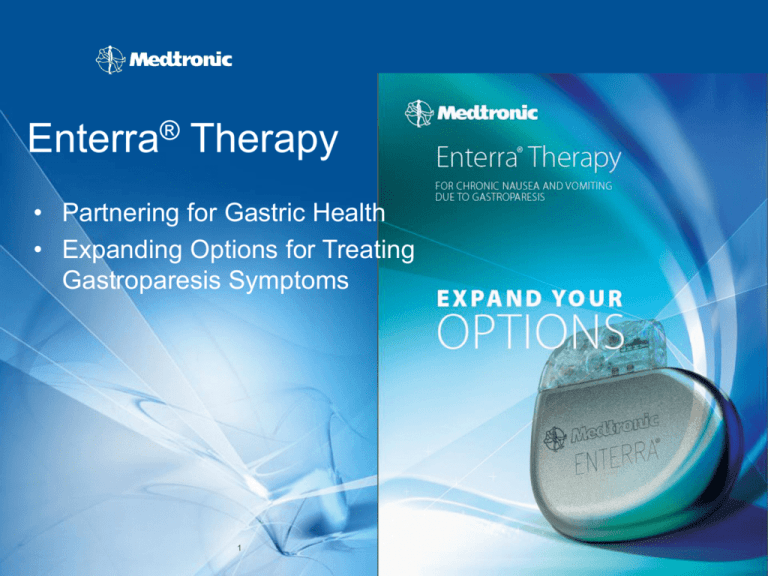
Enterra® Therapy • Partnering for Gastric Health • Expanding Options for Treating Gastroparesis Symptoms 1 Welcome <Insert name(s) of physician presenter(s), practice name/logo, physician photo(s)> <Insert information about therapies, treatments, procedures, and services provided at physician practice> Agenda • Overview of Gastroparesis – What is it? – Patient Quality of Life – Typical Treatment Options • Introduction to Gastric Electric Stimulation – History – Pacing vs Neurostimulation – Enterra® Therapy System • Practice Management Collaboration 3 What is Gastroparesis? Definition Gastroparesis is a stomach disorder in which food is digested more slowly than normal. With gastroparesis, the stomach muscles work poorly (or not at all), thus preventing the stomach from emptying properly. For some people, this condition results in serious nausea and vomiting that cannot be adequately controlled with standard medications. Symptoms • Nausea • Vomiting • Abdominal bloating • Abdominal pain • Early satiety • Heartburn or gastroesophageal reflux disease (GERD) • Changes in blood sugar levels • Lack of appetite • Excessive weight loss/gain 4 What is Gastroparesis? Etiologies In a study of 146 patients, the most common origins were*: • Idiopathic (35.6%) • Diabetic (29%) • Others (35.4%) *Soykan I, Sivri B, Sarosiek I, Kiernan B, McCallum RW. Demography, clinical characteristics, psychological and abuse profiles, treatment, and long-term follow-up of patients with gastroparesis. Dig Dis Sci. 1998;43(11) 5 What is Gastroparesis? Impact The impact of gastroparesis on physical well-being can be devastating. It can cause chronic nausea and vomiting and lead to malnutrition and inadequate blood sugar levels. Living with gastroparesis also affects emotional well-being – the constant discomfort of chronic nausea and vomiting can affect school and work performance, family and personal relationships, and social activities. Diagnosis Diagnosis is based on a complete medical history, physical examination, and tests that may include: • Upper gastrointestinal endoscopy • Gastric emptying test (GET) • Gastroduodenal manometry • Electrogastrography (EGG) 6 Treatment Options for Gastroparesis There is no cure for gastroparesis but there are treatment options that can control the symptoms of chronic vomiting and nausea. Often, multiple therapies are used in combination*. An overview of care for gastroparesis includes: *Abell TL, Bernstein RK, Cutts T, et al. Treatment of gastroparesis: a multidisciplinary clinical review. Neurogastroenterol Motil.7 2006;18(4):263-28 What’s Next for Gastroparesis Patients? My practice can offer an option for your patients who aren’t responding favorably to their existing regimen. Gastric Electrical Stimulation ENTERRA THERAPY 8 Gastric Stimulation Program History 1st Clinical Case Study Animal Study, U. Tenn GEMS Multicenter Feasib. Trial Gastric Emptying Study U VA Pacing Studies WAVESS Trial Compassionate Use CUESS Gastric HUD/HDE US Therapy Launch (DDW) 100 US Implants US RCT European Launch 2009 500 US Implants 1000 US Implants 1500 US Implants 8000 US Implants 1993 1994 1995 1996 1997 1998 1999 2000 2001 2002 2003 2004 2005 9 … 2014 History of Gastric Electrical Stimulation 1963 Bilgutay et al.- The concept of electrical stimulation started when gastric stimulation was practiced for the treatment of postoperative ileus. 10 Pacing vs. Neurostimulation Gastric pacing is a commonly used phrase for gastric electrical stimulation (GES). Enterra® Therapy utilizes gastric electrical stimulation or neurostimulation. • Neurostimulation is an activation of a nausea and vomiting control mechanism, utilizing a high-frequency, low-energy stimulation to achieve symptomatic relief • Pacing is an application of an electrical stimulus that activates contraction of gastric smooth muscle, entraining at the rate of the intrinsic slow wave by a lowfrequency, high-energy method 11 Gastric Pacing vs. Neurostimulation Neurostimulation: Frequency > Intrinsic Low Energy Frequency Pacing: Frequency ~ Intrinsic High Energy Energy 12 Enterra Therapy for Gastroparesis Enterra Therapy with gastric electrical stimulation (GES) is an innovative approach to treating patients with chronic, intractable (drug-refractory) nausea and vomiting secondary to gastroparesis of idiopathic or diabetic origin. The therapy uses mild electrical pulses to stimulate the nerves of the antrum. This stimulation may reduce the symptoms of nausea and the number of vomiting episodes related to gastroparesis.* Introduced by Medtronic, Inc., the world leader in implantable medical technologies, Enterra Therapy can be turned off or removed if there is no longer a benefit. *Abell T, McCallum R, Hocking M, et al. Gastric electrical stimulation for medically refractory gastroparesis. Grastroenterology. 2003; 125(2):421-428 13 The Enterra System 14 Enterra Therapy U.S. Indication “Enterra Therapy is indicated for the treatment of patients with chronic, intractable (drugrefractory) nausea and vomiting secondary to gastroparesis of diabetic or idiopathic origin in patients aged 18 to 70 years.” – Designated as Humanitarian Use Device (HUD) September 23, 1999 by the FDA – Approved as Humanitarian Device Exemption (HDE) March 31, 2000 by the FDA 15 FDA Approval of Humanitarian Device Exemption Enterra Therapy for Gastric Electrical Stimulation has been approved by the FDA under a Humanitarian Device Exemption (HDE)* for the treatment of chronic intractable (drug refractory) nausea and vomiting secondary to gastroparesis of diabetic or idiopathic etiology. A Humanitarian Use Device is an FDA classification covering medical devices for the treatment of conditions affecting fewer than 4,000 new patients per year. The FDA reviewed the safety of the device and determined that the probable health benefits outweigh the risks of injury or illness from its use. Efficacy of treatment, however, has not been established by large clinical trials. Surgery to implant Enterra Therapy for Gastric Electrical Stimulation can only be performed in medical centers that specifically approve its use and have institutional review board (IRB) approval. *Humanitarian Device: The effectiveness of this device for the treatment of Gastric Electrical Stimulation has not been established. Practice Management Collaboration Initial Diagnosis Behavioral Therapies Ongoing General Patient Care Collaborative Process to Optimize Patient Care Device-related Follow-up Enterra Implant Referring Physician 17 Referral Further Diagnostics Specialist/Implanter Trust the Experience of Medtronic Neuromodulation Therapies OCD1 Parkinson’s Disease Essential Tremor Dystonia1 Severe Spasticity Chronic Pain Gastroparesis1 Bladder Control and Bowel Control 1Humanitarian Device Exemption (HDE): The effectiveness of these devices has not been demonstrated. 18 Key Patient Selection Criteria Patient • Idiopathic or diabetic gastroparesis • Chronic, severe vomiting or nausea • Drug-refractory 19 Physician • weighs all available treatment options • evaluates appropriate patients • educates patient and family about therapy and expectations • discusses surgical procedure of Enterra Therapy with patient and family • defines follow-up schedule and expectations Adverse Events Enterra Therapy has risks similar to any surgical procedure, including swelling, bruising, bleeding, and infection. In addition to risks related to a medical procedure, adverse events related to the system may include: • Infection • Pain at the implant site • Lead penetration • Bowel obstruction or perforation • Programming difficulty • Undesirable change in stimulation • Lead entanglement or erosion • Irritation/inflammation over the implant site • Device mechanical or electrical problems Any of these may require additional surgery or cause return of symptoms. Additional information on Enterra Therapy is available at www.enterratherapy.com. 20 Benefits of Referring Your Patients • Manage treatment options for your Gastroparesis patients • Specialized training and education in gastric electrical stimulation • Extensive experience with leading-edge technology and interventions related to neuromodulation • Collaborate to develop a follow-up plan once symptoms are successfully treated 21 Summary • Gastroparesis is very rare and debilitating disease and significantly impacts a person’s health and quality of life. • Patients are often unaware of the various treatment options available. • If conservative treatments have been unsuccessful, refer patients to a specialist for alternative treatment options. • By partnering with a specialist, treatment options can be expanded to help find the best solution to manage gastroparesis symptoms. 22 Important Safety Information 23
